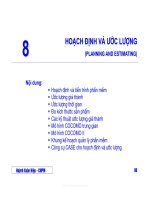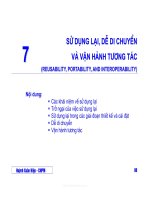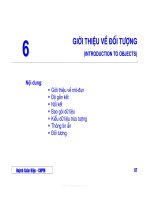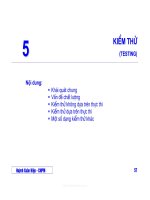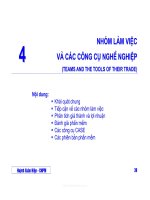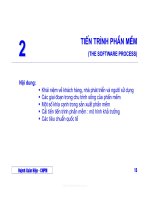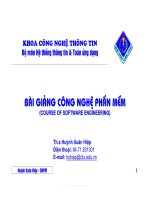Bài giảng Cơ sở tự động: Chương 1 - Nguyễn Đức Hoàng
Bạn đang xem bản rút gọn của tài liệu. Xem và tải ngay bản đầy đủ của tài liệu tại đây (2.01 MB, 62 trang )
MÔN HỌC
CƠ SỞ TỰ ĐỘNG
Giảng viên: Nguyễn Đức Hoàng
Bộ môn Điều Khiển Tự Động
Khoa Điện – Điện Tử
Đại Học Bách Khoa Tp.HCM
Email:
Nội dung môn học (10 chương)
(14 tuần = 42 tiết LT + 14 tiết BT)
Chương 1: Giới thiệu về hệ thống điều khiển tự
động
Chương 2: Mô hình toán học hệ thống liên tục
Chương 3: Đặc tính động học
Chương 4: Khảo sát tính ổn định của hệ thống
Chương 5: Chất lượng hệ thống điều khiển
Chương 6: Thiết kế hệ thống tuyến tính liên tục
Chương 7: Mô hình toán học hệ rời rạc
Chương 8: Phân tích hệ rời rạc
Chương 9: Thiết kế hệ rời rạc
Tài liệu tham khảo
Giáo trình: Lý thuyết điều khiển tự động
Nguyễn Thị Phương Hà – Huỳnh Thái Hoàng
NXB Đại Học Quốc Gia TpHCM
Bài tập: Bài tập điểu khiển tự động
Nguyễn Thị Phương Hà
Tài liệu:
Automatic Control System
Modern Control System Theory and Design
Đánh giá
Thi giữa kỳ : 20%
Thi cuối kỳ : 60%
Bài tập : 20% bao gồm:
+ về nhà có kết hợp mô phỏng Matlab
+ trên lớp : gọi lên bảng làm ( mỗi lần không
làm được 1đ vào điểm thi GK, 0.5đ vào điểm thi
CK )
CHƯƠNG 1
GIỚI THIỆU VỀ HỆ THỐNG
ĐIỀU KHIỂN TỰ ĐỘNG
1769
•
James Watt’s steam engine and governor
developed. The Watt steam engine is often
used to mark the beginning of the Industrial
Revolution in Great Britain. During the
Industrial Revolution, great strides were
made in the development of mechanization, a
technology preceding automation.
Control Systems
6
Control
•
Control is a sequence of decisions aimed
at the attainment of specified objectives
in an environment of uncertainty and
presence of disturbances.
Control system
•
A control system is an arrangement of
physical components connected or
related in such a manner as to
command, direct, or regulate itself or
another system.
Input
•
•
The input is the stimulus, excitation or
command applied to a control system.
Typically from external energy source,
usually in order to produce a specified
response from the control system.
Output
•
•
The output is the actual response
obtained from a control system.
It may or may not be equal to specified
response implied by the input.
History of Automatic Control
Prior to World War II
A main impetus for the use of feedback
in the United States was the development
of the telephone system and electronic
feedback amplifiers by Bode, Nyquist, and
Black at Bell Telephone Laboratories.
Prior to World War II
The Russian theory tended to utilize a
time-domain formulation using differential
equations.
World War II
Design and construct:
•
automatic airplane pilots,
•
gun-positioning systems,
•
radar antenna control systems.
Sputnik and space age
The time-domain methods developed
by Liapunov, Minorsky, and others have
met with great interest in the last two
decades.
Recent time
Recent theories of optimal control
developed by L.S. Pontryagin in the
former Soviet Union and R. Bellman in
the United States, and studies of robust
systems, have contributed to the interest
in time-domain methods.
Terms and Concepts
Two Types of Control Systems
•
Open Loop
•
Closed Loop
–
No feedback
–
Must have feedback
–
Difficult to control
output with
accuracy
–
Must have sensor on
output
–
Almost always negative
feedback
Open-loop and closed-loop systems
Open-loop control
An open-loop control system utilizes an
actuating device to control the process directly
without using feedback.
A common example of an open-loop control
system is an electric toaster in the kitchen.
Closed-loop control
A closed-loop control system uses a
measurement of the output and feedback of
this signal to compare it with the desired
output.


